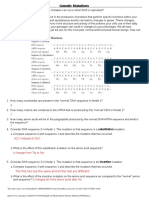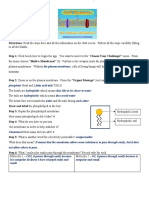67%(3)67% found this document useful (3 votes)
22K viewsImmunity Pogil Packet Key 4 - 8 P
AP BIO ANSWER KEYS
Uploaded by
ElaineCopyright
© © All Rights Reserved
Available Formats
Download as PDF or read online on Scribd
67%(3)67% found this document useful (3 votes)
22K viewsImmunity Pogil Packet Key 4 - 8 P
AP BIO ANSWER KEYS
Uploaded by
ElaineCopyright
© © All Rights Reserved
Available Formats
Download as PDF or read online on Scribd
You are on page 1/ 5
9. Becells are a third type of white blood cell that is involved in immunity.
a, Draw the symbol that represents a B-cell in Model 2.
+b. What is the name of the immune system response that involves B-cells?
Humoral response.
10, According to Model 2, are all B-cells the same? Justify your answer with specific evidence from
Model 2.
No, the ends ofthe surface proteins are different on different Becells.
11. In diagram 2 of Model 2, binding occurs between an antigen and a B-cell. How is this incerac-
tion different from the binding that occurs between antigens and helper T-cells?
In Model 2, the Becell is binding to an antigen that is still part of the whole pathogen organism. In
Model 1, the T-cell did not bind to the antigen until after it had been broken down in the phagocyte
and presented on the surface of the phagocyte.
12. Consider diagrams 3~5 in Model 2. Write descriptions similar to those in Question 5 for each of
these steps in che humoral response.
See Model 2.
13. Isa B-cell an antigen-presenting cell? Justify your reasoning,
Yes, the Beell isan APC because it presents the antigen on its surface ina very similar manner to the
phagocyte.
14, According to Model 2, do B-cells ever interact with pathogens that have infected a cell? Justify
your seasoning with specific evidence from Model 2.
No, the B-cells interact with the pathogen directly when it is free inthe blood.
15. Predict what would happen if a B-cell like the one shown in diagram 5 of Model 2 were to run
into a helper’T-cell like the ones in Model 1.
Since the antigen is presented on the surface ofthe Becell,a helper T-cell could bind to the Becell.
Model 3 - Adaptive Immunity
Pathogen,
* eo
16. Label the following items in Model 3
Pathogen B-Cell Helper T-cell
See Model 3
17. Describe the interaction between the B-cell and the helper T-cell in Model 3.
The helper T-cell is bound to the B-cell atthe site where the antigen is presented on the B-cells surface.
ae when a Belli acivaced by the inceraction with a helper T-cell it begins to produce and dis-
perse antibodies.
44, Draw the symbol that represents an antibody in Model 3.
x
4. According to Model 3, what does the antibody do to pathogens?
The antibody binds to the free pathogens in the blood and forms clumps.
19. How might the interaction between the antibody and pathogens affect the pathogen’ ability o
infect its host?
The clumping of the pathogens by the antibody would make it dificult for the pathogens to enter the
cells ofthe organism and cause an infection
Read This!
‘After the B-cell is activated by the helper T-cell, the B-cell enters a phase of rapid cell division. Some of
the daughter cells become plasma cells that male even more antibody molecules, some reaching a rate of
2,000 molecules pet second. The other daughter cells become memory B-cells that will scay in the body
for several years, ready to respond to the pathogen ifit should ever enter the body again.
Model 4 — Immune Response to a Pathogen
20,
21.
22,
Br
=o
3
ie
zo
3a
Jao) jive Eacoumer
wi the
wo. [Pathogen
Second Encounter
‘Time Jevith che Same Pathogen
“What does the y-axis of the graph in Model 4 represent?
The amount of the antibody in the blood.
How many times did the organism in Model 4 encounter the same pathogen?
Twice.
Using Model 4, compare the amount of the antibody generated by the B-cells after the itst
encounter with the antigen to the amount of the antibody generated in the second encounter
with the antigen.
The first encounter does not create much of the antibody. The second encounter produces a lot more of
the antibody.
Refer co Model 4
4. Compare the time needed to reach the peale amount of antibody production for the frst and
second encounters.
Peak antibody production was reached sooner the second time the organism was exposed to the
pathogen.
}. How does your answer to part explain the fact that we get sick the first time we encounter a
virus, bue we do not get sick the second time we encounter the same virus?
Ie takes longer 10 reach the peak of antibody production following the frst encounter with an anti-
gen, fit takes our body several days to make enough antibodies to fight off a virus the first time, we
will be sick from the virus during that time, During the second infection. though, our body releases
a huge amount of ansibodies almast immediately, effectively defeating the virus before we experi-
cence symptoms of being sick
24, People who are allergic to bee stings are actually having a response to the antibodies produced by
their immune system when they are stung, This is called anaphylaxis. Most people who end up
having a bee sting allergy did not have anaphylaxis the first time they were stung. It is only upon
the second sting, or subsequent stings that they have an allergic response. Use what you have
learned in this activiy to explain this phenomenon.
The firs time the person gets stung by a bee, a small amount of antibody is made over a long period
af time. If they have a reaction to the sting it would be minor. Upon getting stung again however,
a. much more rapid immune response will occur. Many more antibadies are made in a much shorter
amount of time. This causes anaphylaxis.
Fass. considerll he diferent types of cells mentioned in this activity that participate in the immune
response. Which cells are responsible for the response to the second pathogen exposure illustrated
in Model 4 Justify your reasoning.
The memory T, cells and he memory B-cells stay in the body for several years. Those are the cells that
are responsible forthe quick immune response on the second pathogen exposure. Those cells “remember”
the pathogen and are prepared to fight it
26. Consider Models 1 and 2, and the interaction that helper T-cells and B-cells have with the
pathogen.
4. Why is the process in Model | called a “cell mediated” response?
Helper T-cells will only be activated when the antigen is presented on an APC. They cannot re-
spond t0 the free pathogen in the blood.
4. Why is the process in Model 2 called a “humoral” response? Note: Blood was once referred to
as one of the humors of the body.
Becells respond to the free pashogens in the blood.
Extension Questions
27. Consider the life cycle ofa cell. When the memory cells of the immune system ate not activated
or responding to a pathogen exposure, what phase of the cell cycle are they likely in? Justify your
reasoning,
They are likely in the G, phase ofthe cell cycle, meaning they are not dividing or preparing to divide.
Read This!
Edward Jenner, an English country doctor, is credited with giving the first relatively safe vaccine, He no-
ticed that girls who milled cows developed sores on their hands that were similar to the sores of smallpox
victims. These sores were called cowpox, but the gis did noc seem to be sick and they did not become
ill with the dreaded human disease, smallpox. Legend states that Jenner purposely infected a young boy
with serapings from cowpox sores and then exposed the boy to smallpox. The boy did not become ill, and
the practice of vaccinations moved rapidly into mainstream medicine. The word vaccination comes from
the Latin word for cow, vacca. Today, thanks to intensive vaccination practices in the last half of the 20ch
century, smallpox is no longer a dreaded human disease, Since then, vaccines for other diseases like polio
and measles have been developed, and we no longer have widespread deaths from these diseases.
28, Use what you learned in this activity to explain why the girls observed by Jenner did not get sick
from smallpox.
Somchow, being exposed to cowpox led to the creation of antibodies and memory B-cells that ree-
ognized smallpox viruses as well. This allowed the milkmaids' immune system to rapidly respond to
smallpox, keeping them healthy
29. Using the information from this activity and the Read This! box, waite a definition for the term
vaccine, using the terms antigen, antibody, and memory B-cells
A vaccine isa way t0 purposely expose a person (or the immune system) to an antigen or pathogen in a
safe way so that the immune syste matkes memory B-cells hat will produce antigen-specific antibodies
10 protect against another encounter with the pathogen
30. The common cold is a viral disease. So is AIDS, which is caused by the Human Immunode-
ficiency Virus, or HIV. Effective vaccines against these viral diseases have not been developed
despite years of research and work by dedicated scientists. One reason for this is the rapid muta~
tion rate of these viruses, leading to new surface proteins in a very short time. Return to Model 2
+o speculate about how this rapid change in the cold virus and HIV make vaccinations difficult
0 develop.
The vinal antigens are different with each generation of the virus, so the immune system must go
through the entire response process from scratch with each new infection by these viruses. Thus, the
memory B-cells are of no wie, because the virus is different each time,
31. Propose a reason why you must get vaccine “booster” shots every few years.
The memory T,-cells and the memory B-cells do nor last forever in the body. A booster shot exposes the
body once again so there is a slight immnuane response, which increases the number of memory cells in
the body and keeps the immunity strong.
You might also like
- 25 Energy Transfer in Living Organisms-Rennel Burgos43% (37)25 Energy Transfer in Living Organisms-Rennel Burgos6 pages
- Kami Export - Ethan Johnson - 30 The Spread of Pathogens-S33% (3)Kami Export - Ethan Johnson - 30 The Spread of Pathogens-S6 pages
- Kami Export - Gene Expression-Translation-S.161755307489% (9)Kami Export - Gene Expression-Translation-S.16175530746 pages
- Signal Transduction Pathways POGIL Answer Key100% (6)Signal Transduction Pathways POGIL Answer Key6 pages
- Ecological Relationships: What Symbiotic Relationships Are Seen in Ecosystems?100% (1)Ecological Relationships: What Symbiotic Relationships Are Seen in Ecosystems?7 pages
- Gizmos - Evolution, Natural and Artificial Selection67% (9)Gizmos - Evolution, Natural and Artificial Selection9 pages
- 17 Control of Gene Expression in Prokaryotes-S PDFNo ratings yet17 Control of Gene Expression in Prokaryotes-S PDF8 pages
- 25 Energy Transfer in Living Organisms-Swith Manuel Tzul67% (6)25 Energy Transfer in Living Organisms-Swith Manuel Tzul5 pages
- Abdallah Al Obaidi Student Genetic Mutations POGIL100% (1)Abdallah Al Obaidi Student Genetic Mutations POGIL4 pages
- 17 Ecological Relationships-S-Pogil-23natalia78% (9)17 Ecological Relationships-S-Pogil-23natalia13 pages
- Kami Export - Joshua Speedy - Copy of 27 Succession-Research Paper Notes100% (2)Kami Export - Joshua Speedy - Copy of 27 Succession-Research Paper Notes6 pages
- Mark Marlatt - Photosynthesis Pogil Track D - 5261224No ratings yetMark Marlatt - Photosynthesis Pogil Track D - 526122411 pages
- Honors Bio POGIL Prokaryotic and Eukaryotic CellsNo ratings yetHonors Bio POGIL Prokaryotic and Eukaryotic Cells6 pages



























































